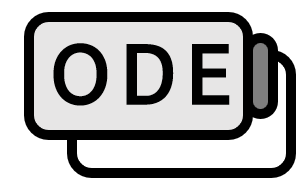Solution to the Bernoulli Differential Equation
Definition
The following first-order nonlinear differential equation is called the Bernoulli equation.
$$ y^\prime + p(x)y = q(x)y^n $$
Here, $n$ is an integer greater than or equal to $2$, and when $n=0,\ 1$, it is a linear equation.
Description
It’s worth noting that the Bernoulli of the Bernoulli differential equation and the Bernoulli of the widely known Bernoulli’s principle in fluid dynamics are different people. The Bernoulli family had many outstanding figures in mathematics and science, resulting in numerous formulas and theorems named after Bernoulli. For more information, click here.
The Bernoulli differential equation is a nonlinear differential equation. Solving nonlinear equations is very difficult and requires a bit of a trick. The trick to solving the Bernoulli differential equation involves transforming the nonlinear equation into a linear one through substitution.
Solution
Step 1.
Since the solution we are looking for, $y$, is equal to $y \ne 0$ dividing both sides of the differential equation by $y^n$ gives us
$$ y^{-n}y^\prime + py^{1-n}=q $$
Step 2.
Let’s make the substitution $u \equiv y^{1-n}$. Then,
$$ \dfrac{du}{dx}=(1-n)y^{-n}\dfrac{dy}{dx} \\ \implies \dfrac{1}{1-n}\dfrac{du}{dx}=y^{-n}\dfrac{dy}{dx} $$
Substituting into the given differential equation we get:
$$ \begin{align*} && \dfrac{1}{1-n}\dfrac{du}{dx} + pu=q \\ \implies && u^\prime + (1-n)pu=(1-n)q \end{align*} $$
Step 3.
Since the given differential equation has become a first-order linear differential equation, we find the general solution for $u$. After that, substituting $u=y^{1-n}$ allows us to finally find the general solution for $y$.
■
Example
Solve the differential equation $y^\prime = Py-Qy^2$.
The given differential equation is a case of the Bernoulli differential equation where $n=2$. Multiplying both sides by $-y^{-2}$ and rearranging gives
$$ -y^{-2} y^\prime +Py^{-1} = Q $$
To solve the differential equation, substitute $u=y^{1-n}=y^{-1}$ to get
$$ \dfrac{du}{dx}=-y^{-2}\dfrac{dy}{dx} $$
Substituting into the differential equation gives us the following equation.
$$ \dfrac{du}{dx}+Pu=Q $$
Using the method for solving first-order differential equations to find $u$ gives
$$ \begin{align*} u&=e^{-\int Pdx} \left[ \displaystyle \int e^{\int P dx}Q dx+ C \right] \\ &= e^{-Px} \left[ \int e^{Px}Qdx +C\right] \\ &= e^{-Px}\dfrac{Q}{P}e^{Px} + Ce^{-Px} \\ &=\dfrac{Q}{P}+Ce^{-Px} \end{align*} $$
Since $u=y^{-1}$, ultimately finding $y$ gives
$$ y=u^{-1}=\dfrac{1}{\frac{Q}{P}+Ce^{-Px}} $$
■
